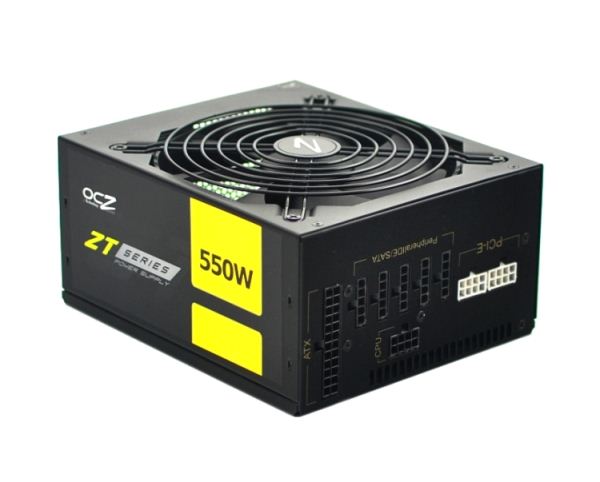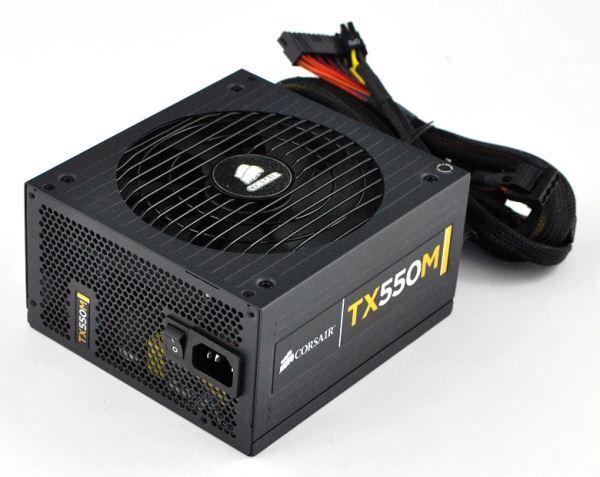Corsair TX vs. OCZ ZT 550W
by Martin Kaffei on March 26, 2012 9:30 AM EST- Posted in
- Cases/Cooling/PSUs
- Corsair
- PSUs
- OCZ
- 550W
- 80Plus Bronze
- ZT
- TX
Corsair TX550M vs. OCZ ZT550W 550W
In this review we will compare two almost identical products from OCZ and Corsair. Even so, there are still crucial differences between the offerings. With 550W both PSUs deliver more than enough power for most current systems. On the following pages we'll find out which handle overload situations the best, who has the highest efficiency, and which PSU provides the best voltage regulation.
The ZT models from OCZ are based on a Great Wall design with some modifications in the details. Interesting features include the fully modular cable management and a silent fan control. Today we will review the smallest version with 550W. Here's a complete rundown of the features.
- Available in 550W, 650W, 750W
- Single +12V rail
- Fully Modular Cabling System
- Dimensions: 150 x 86 x 175mm (W x L x H)
- 80-Plus Bronze Certified
- MTBF: 100,000 hours
- 5-year warranty
- 140mm ball-bearing fan
- Active PFC
- ATX 12V 2.2 Compliant
The second unit we test today is a Corsair TX produced by CWT. "Enthusiast Series is designed for reliable operation in high-performance PCs where clean, stable power is important." It's able to deliver the full output power at an ambient temperature of up to 50° Celsius. Like OCZ Corsair uses a double ball-bearing fan. Except the cables with mainboard connectors all cables are modular. In addition the fan grille looks unusual.
- Available in 550W, 650W, 750W, 850W
- Single +12V rail
- Modular Cabling System
- Dimensions:150 x 86 x 160mm (W x L x H)
- 80-Plus Bronze Certified
- MTBF: 100,000 hours
- 5-year warranty
- 140mm ball-bearing fan
- Active PFC
- ATX 12V 2.31 Compliant












41 Comments
View All Comments
C'DaleRider - Tuesday, March 27, 2012 - link
Why do you persist in posting needlessly obtuse and difficult to decipher voltage regulation charts?Instead of making me do the math....such as figuring out what the +3.3V rail is at +0.61%, why don't you instead simply post what the damned rail started at and drifted down to under loads, such as +3.4V, +3.35V, +3.3V, etc.
No...you have to try to be "different", and by being different you have become obtuse and difficult to decipher.
Simple is good, complex is needless and just silly. I'd suggest you look at the way JonnyGuru and HardOCP lists their voltage and ripple/noise charts to get an idea of what nice, clean, and simple presentations of the information can be instead of your almost useless charts.
When I read reviews, I don't want to be bothered with having to do the calculations in my head to figure out what you mean by a +1% of the +12V rail means. (I'm guessing it's +12.12V, right? That's not hard, but then you get to +0.62% or -0.24% and that becomes stupidly hard.)
Sometimes trying to be different isn't better, just silly.
bobsmith1492 - Tuesday, March 27, 2012 - link
Percent change is a better metric especially comparing across different voltage rails. Everything electronic is specified in percentage tolerance. So percentage measured is the obvious choice.1% of 12V is pretty easy if you want absolute values for some reason. 12x1.01. I suggest you go back to middle school.
philipma1957 - Wednesday, March 28, 2012 - link
It arrived yesterday. Newegg had it for 69 on shellshocker 20 rebate is 49 and a 15 dollar gift card my cost was 37 dollars due to sales tax. At 37 bucks it is a good deal. I think I will put in a better fan. I will look to see if I can get the sanyo denki fan that the author has picked out. I will also add a piece of insulation between the modular pcb and the main pcb.Reading this info has inspired me to check on my 660watt seasonic psu as every once in a while the computer shuts down for 1 spilt second, it will not hurt to take a look. To me the biggest problem with the ocz in the review is the lake of input voltage regulation. This means a good ups/voltage regulator should supply the psu. I have that. I have some good thin insulation. So i will need to get a fan. well so far only 37 spent on this psu. I wonder what the sanyo fan costs.
Beenthere - Wednesday, March 28, 2012 - link
The Sanyo fan is $45.99... :(philipma1957 - Friday, March 30, 2012 - link
Thanks for the fan price. Too much so I grabbed an antec true quiet 140mm fan for about 15.50 at amazon. Both parts arrived on the 29th. I tested it with the stock fan and the antec a lot quieter. So my 37 dollar bargain is now about 52 bucks. I have a lowcost Nxzt case and I was able to route the antec's fan switch behind and lower then the cpu on the other side of the case. Since the case has easy access to that side panel I can switch the fan to low setting if I choose. I also was able to attach the fan's power cord to the mobo So I can monitor its speed .The unit appears well built and the solder work inside the case looked clean. I added a thin piece of rubber as suggested to prevent any arcing issues between the power jack pcb and the main pcb. I will get back to this with an update to let you know how well the unit holds up in daily use. I paid a total of 52-53 for this.
my 660 watt seasonic was 116. Still not sure if the seasonic has an issue or some other problem cause rare spilt second black outs every once in a while.
this ocz is going into my amd lower cost build. about (500)
while the seasonic is in my intel higher cost build. about (1k)
philipma1957 - Monday, April 2, 2012 - link
Amd fx-41002 x 4gb patriot/amd 1333 ram
gigabyte 970 atx mobo
a crucial m4 128gb ssd
a coolermaster 212 evo
a sapphire hd6670 passive cooled gpu
The psu runs very quiet . the antec fan is much quieter the the stock fan. seems like a good buy.
StrangerGuy - Monday, April 2, 2012 - link
$90 for a 550W PSU? Are you kidding me? And it's ONLY 80+ Bronze. I got a Seasonic S12 520W for only $60.I can see why there are so many players in the PSU market, all thanks to the enormous profits to the PSY FUD crowd who spouting nonsense like "400W isn't enough for the average gaming PC" brings.
philipma1957 - Tuesday, April 3, 2012 - link
you are corect it is not worth 90 bucks. but AR it is 70 at amazon. I paid 50 AR and I a got a 15 dollar gift card to boot. so it was 35 bucks. the fan was to loud and with the mod I did it was 52 bucks. it is worth 52 bucks.mikeymikec - Thursday, April 5, 2012 - link
Considering how a desktop PC without a graphics card and a decent PSU can run virtually silent these days, I think more work could have been done in the audible noise from PSUs.My first thought in how to achieve this would be to do a review of 12-14cm chassis fans, pick the most quiet one, then use that as a reference for PSU testing in future. Give an opinion on the noise level on each PSU reviewed like you've done here (because fans can emit extra irritating noises like a whine while still being quiet, but also compare it to that one, also possibly measuring the noise level and providing measurements of, say, +2dB (or whatever is considered the best method of measuring audible noise levels) above reference fan.
I've bought a lot of Corsair VX range PSUs and a few since the VX range was discontinued, and the TX ... M range are much noisier, as in, they're easily the highest noise producer in a modern system. At least with the VX range the noise level was approximate the same as the CPU and chassis fans in the system (without either of those being unusually decent fans, a stock CPU fan and a Coolermaster 12cm fan that comes with the Coolermaster cases I typically use).
mikeymikec - Thursday, April 5, 2012 - link
First para: I meant, more work could have been done to measure/analyse/give a useful opinion on the audible noise from these PSUs. What I can take away from this review is "they produce some audible noise".